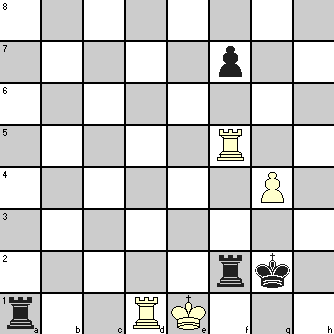While showing you some common traps in chess, we pointed out how the same themes occur in master games at different periods of time. That is why it is important to assimilate such chess tactics and look for opportunities to apply those in your games. Of course the board situation will never be identical, but the pieces participating in such combinations will be occupying more or less similar positions. Sometimes you may have to make some preparatory moves to get the pieces where you want them if you can identify the pattern and the potential to deploy the thematic moves.
If you learned the lesson on how Bishop and Rook can combine on the eighth rank, it should not be a problem to identify the similarities between the following two positions. The first one dates back to 1864 and arose in a game between two relatively unknown players, Maczusky with White and Kolisch with Black. The second is from a game held in 1910 between two well-known Grandmasters Reti (White) and Tartakover (Black).

Do you identify the similarity between the two positions and also with the theme shown to you in the article referred above?
The games proceeded as follows:
| 1. | f4 | Qxf4+ | 1. | Qd8+ | Kxd8 | |
| 2. | Bd2 | Qf5 | 2. | Bg5+ | Kc7 | |
| 3. | Qd8+ | Kxd8 | 3. | Bd8# | ||
| 4. | Bg5+ | Ke8 | ||||
| 5. | Rd8# |
Any discussion on endgame studies cannot be considered complete unless it includes ‘Saavedra position’. But though we did not name it, the position has been seen by you in the second problem in our article on winning chess strategies. The name comes from Saavedra, a Spanish priest, who suggested the under-promotion as the winning line in the position previously considered as ‘drawn’ and he may be the only chess player ever to become famous for a single move!
In endgame tactics, it is often easy to miss some finesse available to you or your opponent that may change the complexion of the game. Be always alert to look for such possibilities before proceeding with the moves that may seem obvious! Following is an example where Black missed such opportunity while making his move.

The game proceeded as follows:
| 1. | … | Rxd1+ | ||
| 2. | Kxd1 | Rxf5 | ||
| 3. | gxf5 | Kf3 | ||
| 4. | f6 | Kf4 | ||
| 5. | Ke2 | Kf5 | ||
| 6. | Ke3 | Kxf6 | ||
| 7. | Kf4 | White got the opposition and a drawn game |
In playing above, Black missed the following line that would give him a win!:
| 1. | … | Rf1+ | ||
| 2. | Rxf1 | Rxd1+ | ||
| 3. | Kxd1 | Kxf1 | Now Black gets the opposition and wins the game! |

